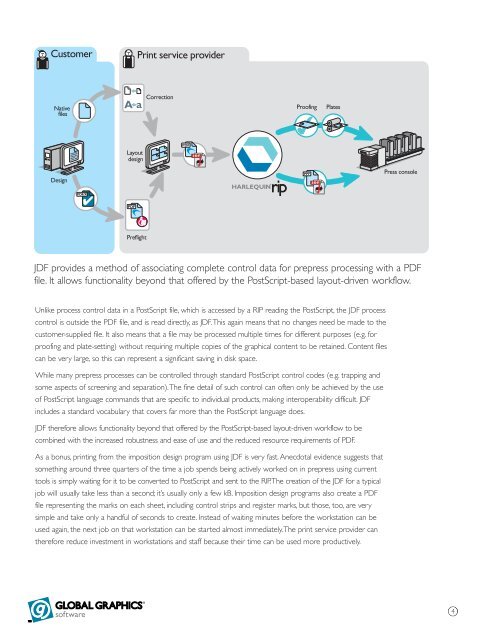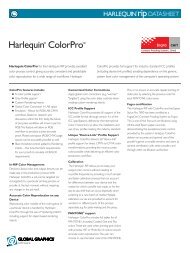JDF for small pre-press sites - Global Graphics
JDF for small pre-press sites - Global Graphics
JDF for small pre-press sites - Global Graphics
Create successful ePaper yourself
Turn your PDF publications into a flip-book with our unique Google optimized e-Paper software.
CustomerPrint service providerNativefilesCorrectionProofingPlatesLayoutdesignPDFDesignPPFPress consolePDF/X✔PDFPreflight<strong>JDF</strong> provides a method of associating complete control data <strong>for</strong> <strong>pre</strong><strong>pre</strong>ss processing with a PDFfile. It allows functionality beyond that offered by the PostScript-based layout-driven workflow.Unlike process control data in a PostScript file, which is accessed by a RIP reading the PostScript, the <strong>JDF</strong> processcontrol is outside the PDF file, and is read directly, as <strong>JDF</strong>. This again means that no changes need be made to thecustomer-supplied file. It also means that a file may be processed multiple times <strong>for</strong> different purposes (e.g. <strong>for</strong>proofing and plate-setting) without requiring multiple copies of the graphical content to be retained. Content filescan be very large, so this can re<strong>pre</strong>sent a significant saving in disk space.While many <strong>pre</strong><strong>pre</strong>ss processes can be controlled through standard PostScript control codes (e.g. trapping andsome aspects of screening and separation). The fine detail of such control can often only be achieved by the useof PostScript language commands that are specific to individual products, making interoperability difficult. <strong>JDF</strong>includes a standard vocabulary that covers far more than the PostScript language does.<strong>JDF</strong> there<strong>for</strong>e allows functionality beyond that offered by the PostScript-based layout-driven workflow to becombined with the increased robustness and ease of use and the reduced resource requirements of PDF.As a bonus, printing from the imposition design program using <strong>JDF</strong> is very fast. Anecdotal evidence suggests thatsomething around three quarters of the time a job spends being actively worked on in <strong>pre</strong><strong>pre</strong>ss using currenttools is simply waiting <strong>for</strong> it to be converted to PostScript and sent to the RIP. The creation of the <strong>JDF</strong> <strong>for</strong> a typicaljob will usually take less than a second; it’s usually only a few kB. Imposition design programs also create a PDFfile re<strong>pre</strong>senting the marks on each sheet, including control strips and register marks, but those, too, are verysimple and take only a handful of seconds to create. Instead of waiting minutes be<strong>for</strong>e the workstation can beused again, the next job on that workstation can be started almost immediately. The print service provider canthere<strong>for</strong>e reduce investment in workstations and staff because their time can be used more productively.4







